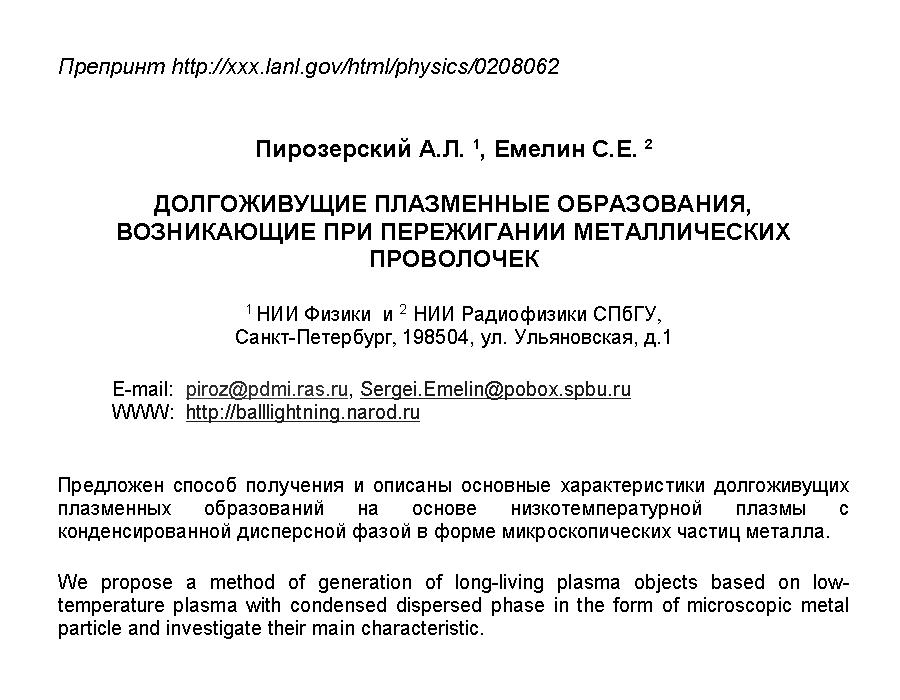

1. Introduction
Investigation of long-living plasma formations (LLPF), arising from different types of erosional discharge [1¢4] is of doubtless interest both for understanding principle mechanisms responsible for metastability and structure-energy self-organization processes in low-temperature plasma with condensed dispersed phase and for laboratory modeling of such rare and transitory natural phenomena as ball lightning, sprites, blue jets, etc.
The present paper is devoted to the experimental study of LLPF, arising from metal wires burning by electric current of medium magnitude (20¢100 A) (LLPF-MW). Erosional plasma, appeared at wire burning, maintains the discharge. The plasma volume undergoes a series of structural changes, resulting in formation of a mushroom-shaped object, which changes then into a quasi-spherical plasmoid and then into a torus. LLPF-MW are characterized by anomaly long lifetime (about 0.2¢0.3 s, that is three orders of magnitude greater than relaxation time of equilibrium plasma at given conditions) and by considerable spatial non-homogeneity (e.g., the presence of fiber- and filament-like structures and of envelopes). They can kindle some dielectric materials, for example the cotton wool.
2. Experimental setup and dischargers construction
The experimental setup consists of a pulse storage capacitor C0 = 0.6mF x 5kV, inductance L= 40mkH ¢ 7.6mH, integrated with pulse ignition transformer (resonance frequency 0.03 ¢ 0.3MHz, pulse voltage up to 50kV), current limiting resistor (R = 10 ¢ 400 Ohm ), protecting spark gap (4 mm in length) and main discharger.
The main discharger consists of a base in the form of a narrow dielectric plate, in the middle of which dielectric supports or partitions were installed. . A wire to burn, shaped as inverted V letter, was extended over the top edge of the partition, its ends being fixed by clamp placed at the edges of the base.
We used a camcoder Sony DCR-TRV11E, sensitive in the near infrared range, for videorecording.
In some experiments the erosional water discharger, whose construction was similar to the one from [3,4], was connected in series with the spark gap and the main discharger.
3. Discharge modes and main characteristics of LLPF-MW
In our experiments we used wires made from different metals, in particular, from copper, iron and nichrome. The best results were obtained with copper wire of 0.1mm in diameter.
At too low (<30 Ohm ) or too high (>600 Ohm ) values of current limiting resistor LLPF did not appear. In the first case the wire exploded with formation of a dust cloud, luminosity of which decreased rapidly and extinct after about 20 ms. In the second case only a small segment of the wire burned out followed by discharge breaking. For copper wire 0.1 mm in diameter at storage capacitor voltage range 1 ¢ 5 kV optimal value of the resistor was 70 ¢ 150 Ohm.
The following sequence of images presents selected frames from videorecording showing different stages of LLPF-MW evolution.
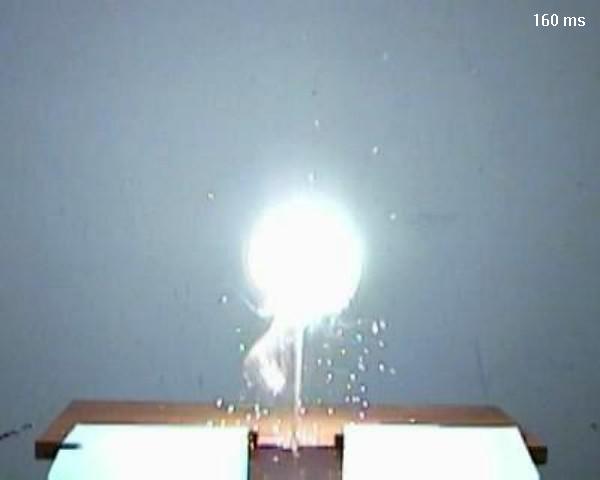
At upper-rigth coner of each image the time when image was taken
is given, starting from the discharge beginning. In this experiment initial
storage capacitor voltage was 3.1 kV, the residual oneŚ 1.0 kV, the resistor
value Ś 86 Ohm. A copper wire of 0.1 mm in diameter was used. The oscillogram
of current, which will be shown some later, evidences that the current
breaking occurs at about 90 ms after the discharge beginning, so this object,
having practically perfect spheric form, exists already 70 ms after the
current breaking.

Here the shape of the object has became less regular, but its brightness is still sufficiently high.
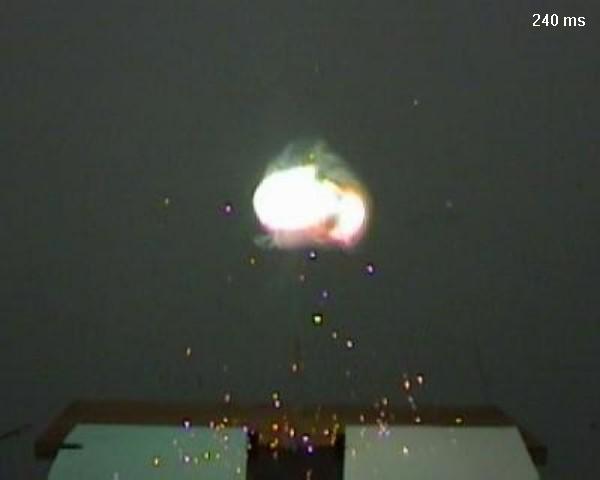
Now we see that the shape of the plasmoid changes gradually to toroidal one.
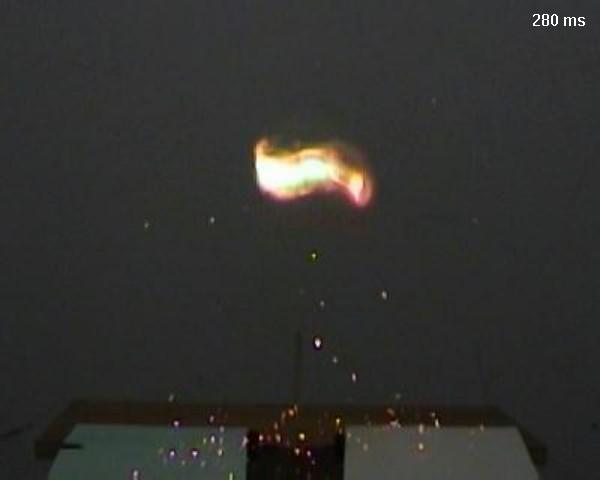
The luminescence of the object diminishes gradually and disappear after about 0.4 s.

Two following images were processed for contrast and brightness enhancement.
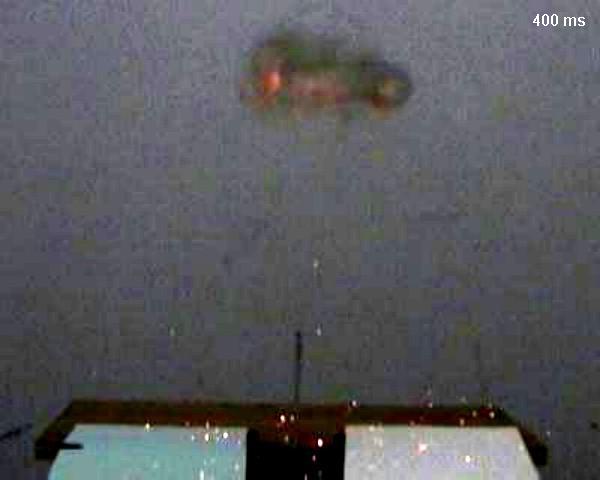
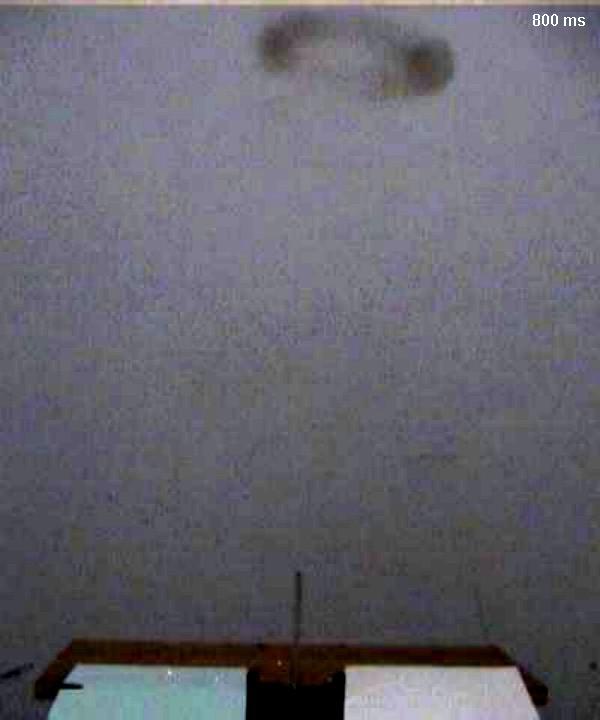
The residual dusty toroid lives up to 5¢10 s, and its shape becames even more regular, as can be seen by comparing this image with the previous one. Moreover, the toroid possess of a relative stability of the shape, for example, it can pass around a barrier placed on its way by means of increasing of its horizontal diameter.
It should be noted that the shape of the objects obtained by metal wires
burning and dynamics of its evolution depend heavily on many factors,
among them the aerodynamic conditions, in particular, size and shape of
the partition installed in the discharger, the presence of nearby objects,
affecting convective motion of air, and parameters of the discharge
circuit.
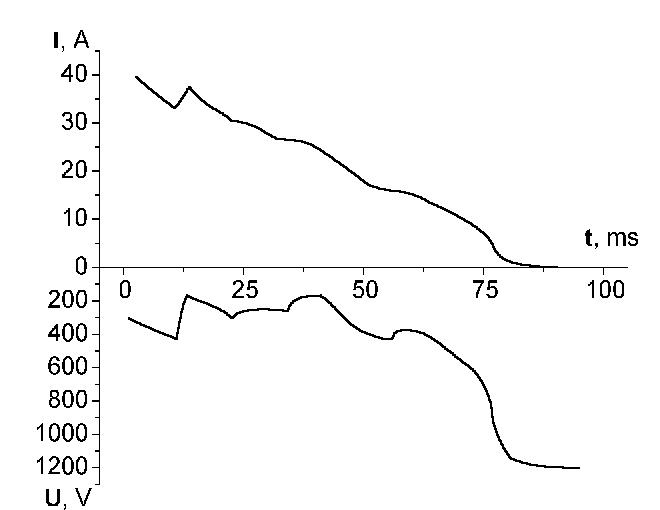
This slide shows the oscillogram of the discharge current and the voltage measured on the protection gap and main discharger connected in series .
Oscillations of the current and voltage evidence about occurrence of undulatory processes in the erosional plasma appeared at wire burn, and are related, more probably, with acoustic waves in dust skeleton formed by metallic particles of micron and submicron sizes.
In most cases the long living plasma formations, appearing at metal wires burning, have a pronounced spatial non-homogeneity. This non-homogeneity manifests itself by the presence of filament-like structures and/or of weakly luminous envelopes.

On this image a filament-like structure is apparently visible in lower part of the object.
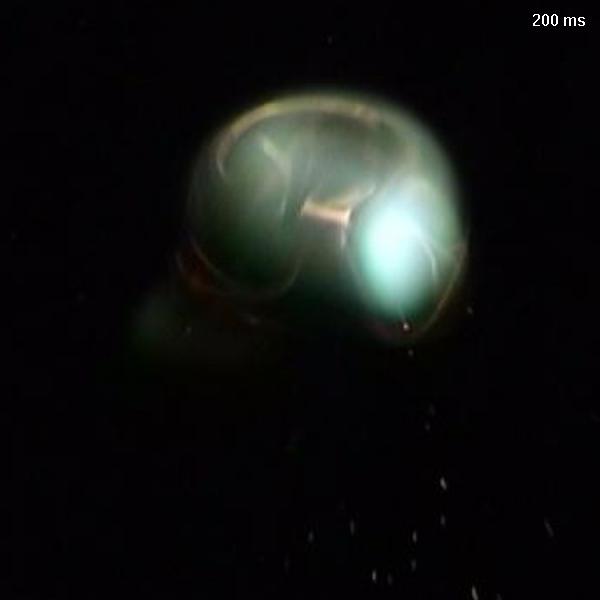
The same object after 40 ms. A weak luminous envelope is visible.
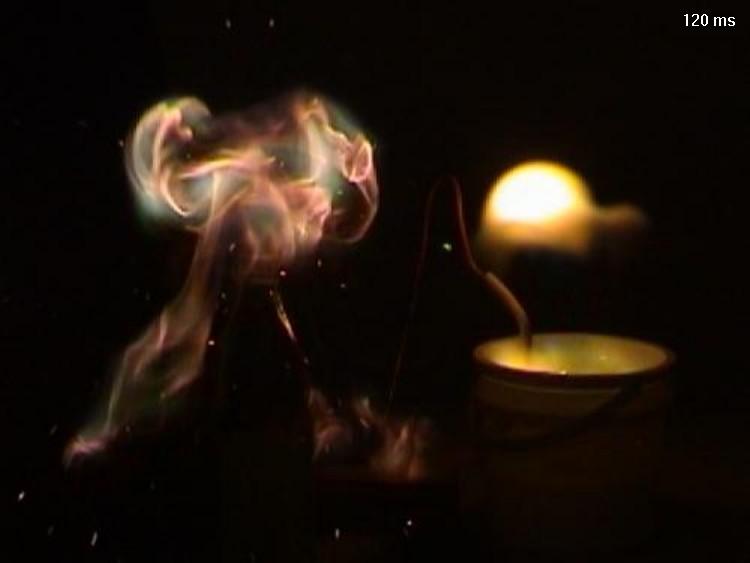
On this image a complex filament structure of the LLPF-MW is clearly visible. On the right we see a plasmoid, appeared from the high voltage erosional water discharger, which in this experiment was connected in series with the main discharger.

Another object with envelope. One can see a sheaf of the metal
particles of large sizes, picking the envelope. Note that at this moment
the upper object is autonomous because of short circuit by the lower plasma
volume.

Here the envelope forms a roll in upper part of the object. Also, the cathod (right) and anode (left) erosional jets are distinctly visible, which inflate the envelope; note that they are of different colors.
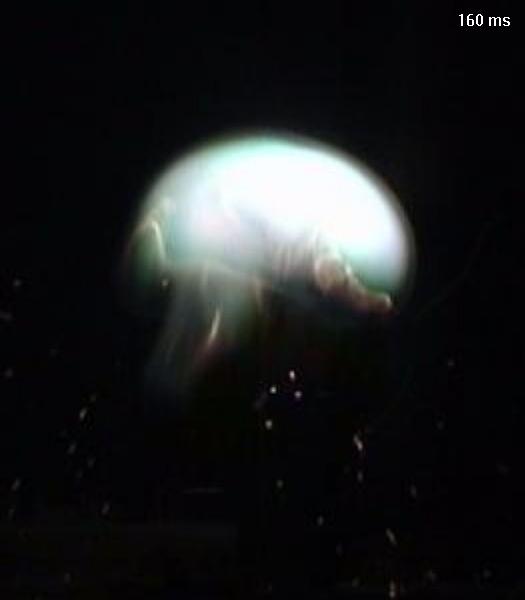
The same object after 40 ms.
The folowing 4 images show the formation and evolution of the envelope.
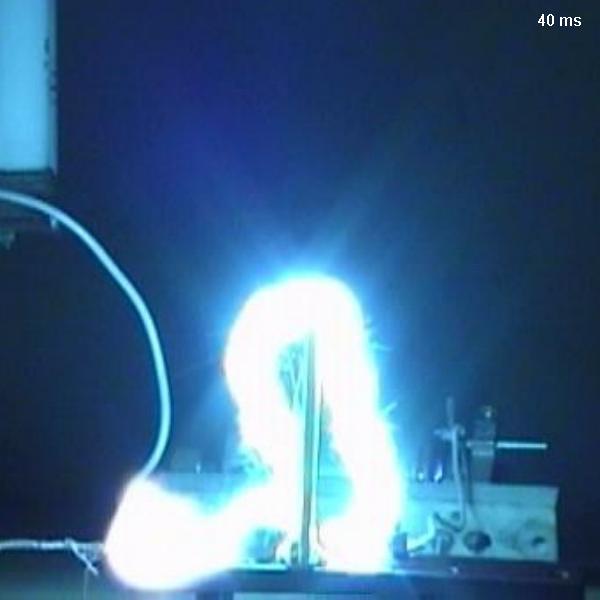
The first frame. We see a plasma cord which has formed around (and in
place of) the wire.
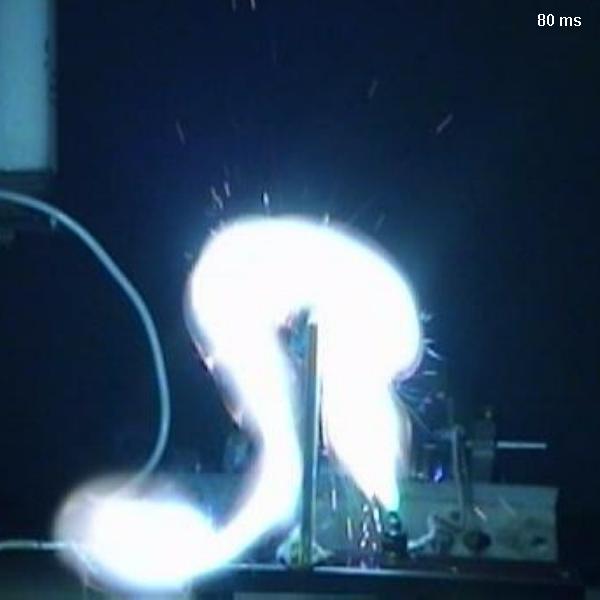
At 80 ms the envelope is already appeared. The plasma volume at the
lower-left corner is probably due to a faulty contact at the left (positive)
terminal.

Object is now autonomous. The envelope is distinctly visible, as well as a system of filaments (fringe) at right lower part of the main object. Note that the second object also has a filament structure.
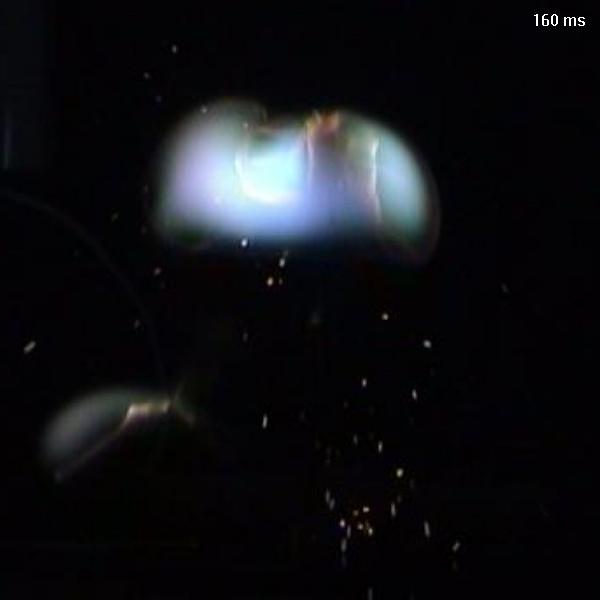
The relaxational phase. The envelope is still visible, especially at the right part of the obect. Note that here different colors are presented. Luminiscence the object are apparently of a non-thermal nature.
I showld be noted that floating-up velosity is very low, which implies that average temperature of the object does not exceed 330K (as estimated by Stepanov et al at similar situation for water discharge plasmoids, assuming the floating up velosity to be about 1 - 1.2 m/s)
For direct comparison of these two types of LLPF the corresponding dischargers were connected in series, that enabled simultaneous observation of the both objects, as shown on the following images.

Here MW plasmoid is on the left, the HVEWD one - on the right. An irregular shape of the first plasmoid is due to improper position of the wire.
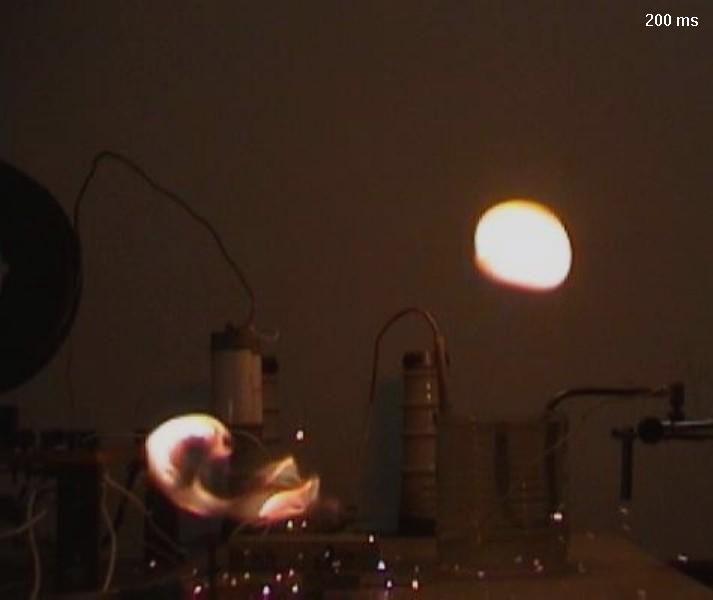
MW object is already turned into a torus, WD one has a regular ellipsoidal form.

Now the both objects turned into torus.
So, we see that the both objects have a similar dynamics, but in average the LLPF-WD lifetime was 10-20% greater, which is connected, seemingly, with lower temperature of the latter.
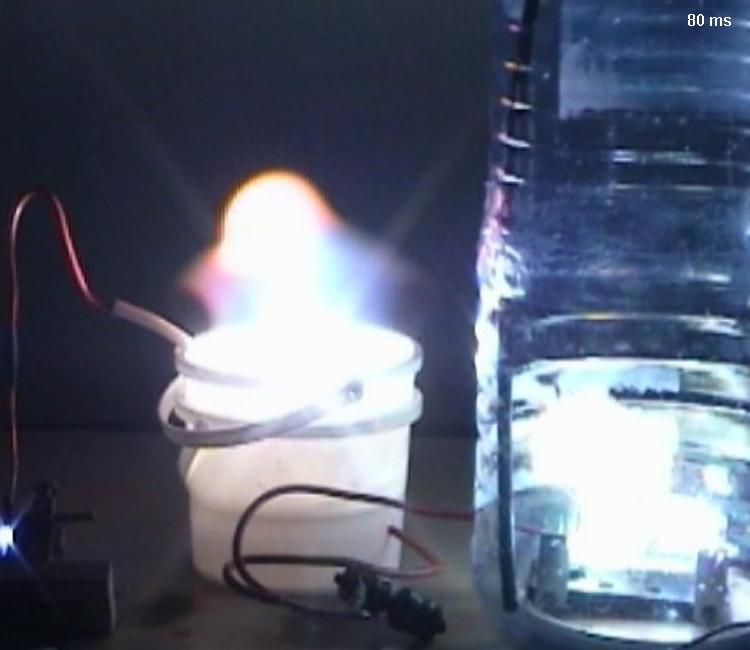
To clarify the role of oxidation processes we carried out an experiment on LLPF-MF generation in the CO2 atmosphere. Here again the main discharger was connected in series with the HVEWD one. Discharge conditions were not optimized, so both object have relatively short lifetime.
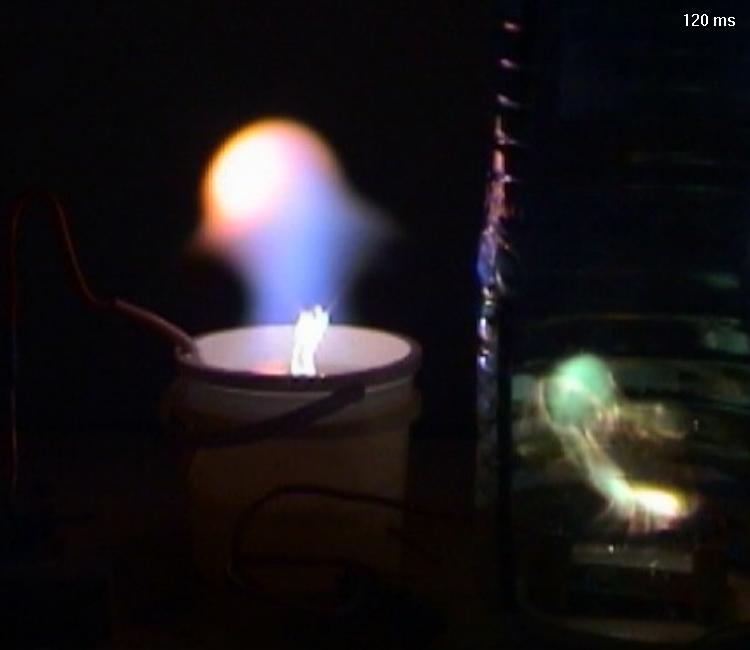
We see here that in the CO2 atmosphere the MW plasmoid is smaller (this can also due to another construction of the discharger used) and its lifetime was shorter. Decreasing of LLPF luminosity and change of its color to green, characteristic for copper vapors, are may be connected with the absence of the nitrogen, which has many bright spectral lines both in the red and the blue spectral range. The object floats up more slowly, which can be explained by air-dynamics conditions change due to increasing of the gas density and due to the presence of the nearby column walls. Nevetherless, this experiment shows, that LLPF-MW can appear in CO2 atmosphere, so the oxidation processes are not crucial for their existence.
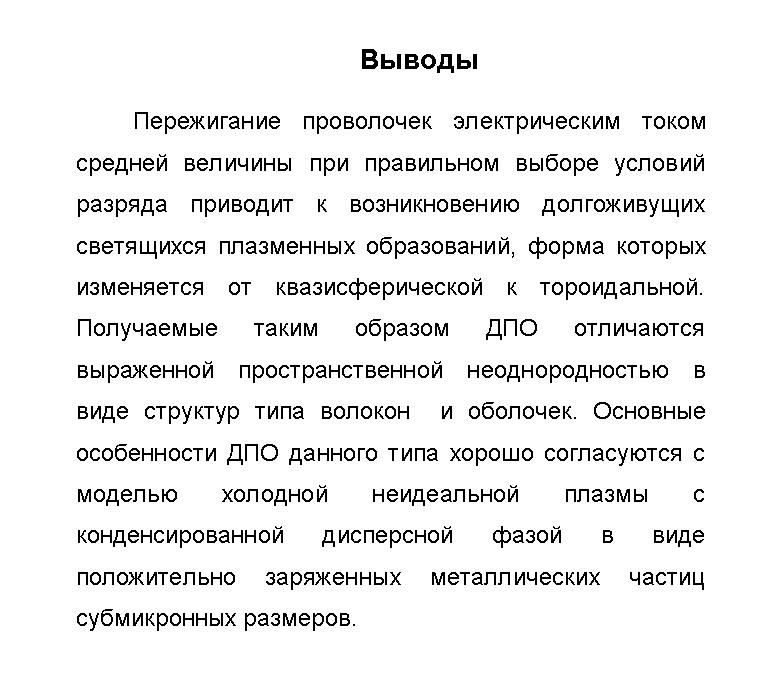
Finding out main mechanisms of metastability and determination of the energy storage form are of principal importance for understanding the LLPF physical nature. At the present several models were proposed (see [6¢10] and references therein), but the available experimental data do not allow to choose undoubtedly only one of them.
In the paper [4], devoted to studying LLPF-WD, it was proposed, following the model from [10], that the base of LLPF-WD is cold plasma consisting of clusters of hydrated ions, which the main part of the object energy stored in. The hydrate envelopes prevent approach and recombination of ions, that, by opinion of the writers [4], determines the metastability of the plasmoid.
Studied in the present paper LLPF-MW have similar basic characteristics, of which in this case the most important ones are anomalously long lifetime and the presence of non-equilibrium energy store (the latter is confirmed also by that fact, that LLPF-MW even at last stages of the existence ignites cottony cotton, though mean gas-kinetic temperature calculated from on speed of a up-floating exceeds only a little the room one). As the formation of the plasmoid occurs in conditions, when the concentration of water vapour is negligible, the metastability LLPF-MW can not be explained by the hydration mechanism. The similarity of the parameters LLPF-MW and LLPF-WD allows to suppose, that this mechanism can not be determining nor for LLPF-WD.
That fact, that formation LLPF-MW can occur in the CO2 atmosphere, evidences that the process of oxidation of the metal nor can serve the main power source of the plasmoid.
The main features of LLPF-MW can be explained by the hypothesis, that the base of the objects is highly non-ideal plasma with condensed disperse phase in the form of metal particles, of micron and submicron (presumptively about tens¢hundreds nanometers) sizes arising at vaporisation of the wire. The influence of the discharge radiation and current leads to electron excitation and ionization of the particles. At the same time the free electrons are fast bounded by electronegative gas, that results in the charge separation, the positive charges being located on the metal particles. The charge of a particle can attain thousands e, that implies high Coulomb non-ideality of the plasma, and, therefore, results in the capability of appearance of collective effects, that is indirectly sustained by the oscillations of discharge current and voltage. The strong collective interaction of the particles leads to development of plasma instability of different types and to formation of filament-like spatial structures. The envelopes consist, apparently, of metal oxides formed on the plasmoid boundary.
Conclusions
The burning of metal wires by electric current of medium magnitude,
at proper choice of the discharge conditions, results in generation of
long-living plasma formations. The plasmoids live 0.2-0.3 s after discharge
breaking, their shape evolves from quasi-spherical to toroidal. The LLPF-MW
are high non-homogeneous spatially that manifested by the presence of fiber-
and filament-like structures and of envelopes. The main features of LLPF-MW
may be explained by the model of cold non-ideal plasma with condensed disperse
phase in the form of positively charged metallic particles of micron and
submicron sizes.